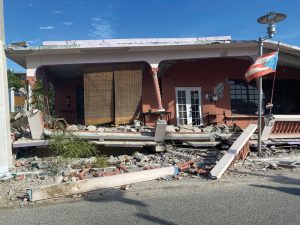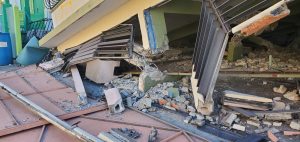The Reality Not Covered in the Media
Ponce is a beautiful coastal city that was once the capital of colonial Puerto Rico. Its magnificent houses and historic buildings, often exceeding 10,000 square feet, survived for centuries but were damaged by the January 2020 magnitude-6.4 earthquake. In some locations, ground acceleration exceeded 50 percent of gravity – something we expect in highly seismic regions like the Western U.S. – and many buildings are now red-tagged, labeled too dangerous to enter. The island’s economy has suffered from depopulation for decades, with an estimated one million people leaving in the last decade alone. Hurricane Maria in 2017 accelerated this trend, so many of the buildings impacted by the earthquake were not occupied nor maintained.
The earthquake damaged about 10 percent of the building stock in the impacted towns. A few hundred collapsed. Most structures are of concrete frame construction with infill of unreinforced masonry units. Puerto Rico uses the International Building Code (IBC) and a licensing system similar to the mainland U.S., but only half of all residential buildings receive valid construction permits. Many newer houses sit on slender columns without proper ductile details. The open area below is commonly used for BBQs or parking, but this soft story construction is a major collapse hazard. There are still more than 100,000 of these dangerous buildings standing on this island.
Over 25% of the impacted schools were damaged, and one collapsed. Most of the damaged schools are concrete with non-ductile construction and built prior to 1987 when the building code was updated with seismic provisions. It was fortunate that the earthquake happened during a holiday; otherwise, Puerto Rico would have lost a few hundred students.
The island has not experienced an earthquake disaster of this magnitude in over 100 years, so the public was not quite ready for it. Unlike hurricanes, earthquakes have no warning, nor a beginning or end. Aftershocks are still rumbling and causing anxiety. Roof or window damage from hurricanes is easy to see, but cracks caused by earthquakes are mysterious. It can be hard to tell if superficial cracks indicate more serious structural damage. One of the ways to provide confidence for the public has been for structural engineers to conduct Rapid Damage Assessments house by house.
There were more than 8,000 displaced people in tent cities and more than 10,000 buildings damaged in January. When Miyamoto International arrived with a team of disaster response specialists, the government was just establishing a rapid damage assessment system and training engineers. Eight weeks later, 80 percent of buildings had been assessed using the ATC 20 rapid assessment procedure. The displacement camps are reduced to about 600 people, thanks to Rental Housing Assistance vouchers. Almost all roads damaged by landslides have been repaired, and 100 percent of the electrical service has been restored.
While the response phase winds down, the most challenging component starts – recovery. Is this going to accelerate depopulation and more empty houses, or can this trigger economic expansion? The answer depends on policy funding. After Hurricane Maria, billions of dollars were allocated by Congress, but only a fraction of it was spent. Why? There was a 10% match required by the federal government. But Puerto Rico was already bankrupt before Maria, so there was simply no money for matching. This time, the matching requirement for FEMA public funding is 25%. This reality needs to be resolved rapidly.
The quick solution after an earthquake is to demolish damaged buildings as fast as possible. However, once a building is taken down, it takes a lot of money and time to reconstruct. Empty lots deter private investment, and it can take years to build back a city.
As the team assessed damaged buildings, it was estimated that more than 90% of yellow tagged buildings and more than 50% of red-tagged buildings could be repaired at a fraction of the cost and time of demolition and reconstruction. Between 10,000 to 20,000 residential and heritage buildings need to be examined for repairability. This can be done swiftly. Engineering technology can help avoid empty lots and protect this beautiful city’s history, while construction can encourage economic expansion and investments in the future.■
